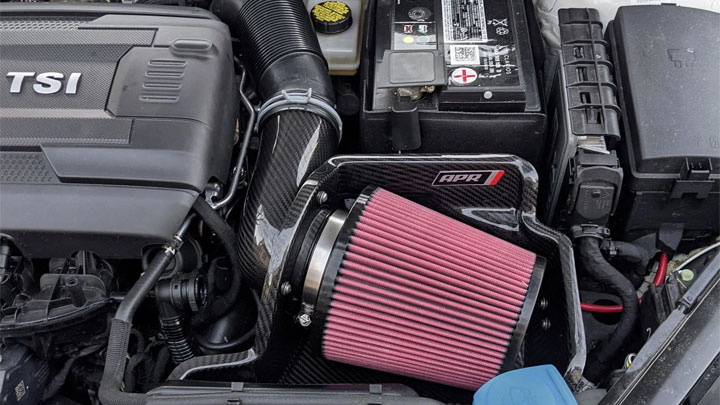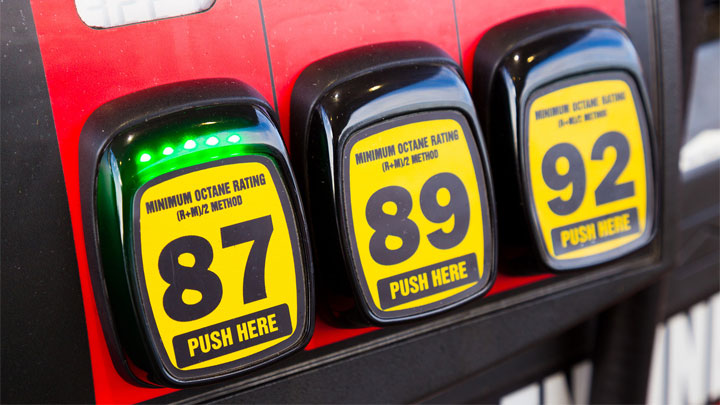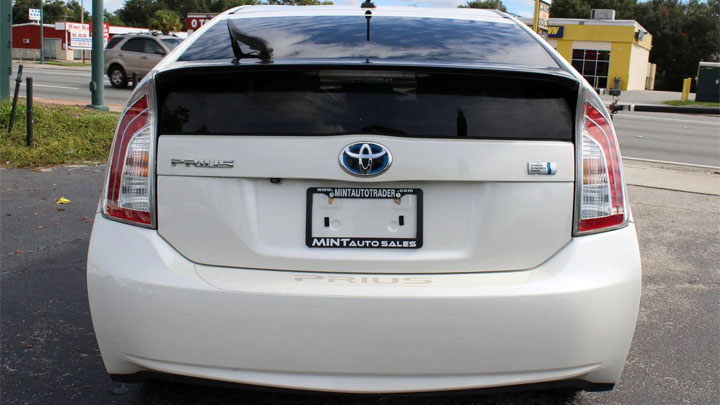Cold Air Intakes: Are They Worth the Money?
One of the first things many car enthusiasts upgrade when they get a new car is the intake system. The reason is pretty simple… they’re easy to install, widely available, and they offer a bit of a performance boost.
But what can you really expect from a cold air intake? How do they work? And are they really worth the money? We’ll answer those questions and more.

See Also: 30 of the Worst Car Mods You Can Make
What Is a Cold Air Intake?
Most OEM intake systems take air from inside the engine compartment and pump it into the engine from there. While this works to keep your engine running, colder air has more oxygen which burns better.
Cold air intakes take air from outside the engine compartment and pump them into the engine. The colder air burns better and improves performance.
Not only that, but many cold air intake systems increase the amount of air the intake system can bring in, and the ability to pull more air into the engine helps improve performance too.
Cold Air Intake vs Short Ram Intake

Both cold air intakes and short ram intakes are all about improving the performance of your vehicle, but they go about it in different ways. Short ram intake systems don’t pull colder air in from outside the engine, instead they simply shorten the entire intake system.
Shortening the intake reduces the amount of restriction in the system, which lets more air get to the engine faster.
While short ram intakes certainly help improve performance, they generally have better results at higher RPMs, and as the engine heats up, you’ll notice some performance dips.
Open vs Closed Cold Air Intakes

If you’re getting a cold air intake system, there are two different types for you to choose from. Those options are open and closed cold air intakes, and it’s talking about whether or not anything is surrounding the filter.
Open cold air intakes use an exposed air filter, which increases the amount of airflow that makes it to and through the filter.
Meanwhile, closed cold air intake systems put a box around the air filter and only let air through small slits. This creates a restriction on the air, but the rest of the box helps keep the entire intake cooler, getting colder air to the engine.
There’s a lot of debate around whether an open or closed cold air intake is better, but we think it all comes down to what you want from the engine.
- If you only care about the performance gains, go with a closed cold air intake.
- If you want a cleaner-sounding intake, then an open cold air intake is the way to go.
How Much Horsepower Does a Cold Air Intake Add?
Manufacturers tend to make some outlandish claims regarding how much horsepower their cold air intake system will give you. They come up with these numbers in idealistic situations you’ll never find in the real world. That’s why we recommend ignoring the label and instead looking at the cold air intake itself.
The right closed air intake can add between 5 and 10 horsepower to your engine, but somewhere between 5 and 7.5 horsepower is most common. Meanwhile, closed air intakes typically add right around 5 horsepower.
But every situation is different, even when comparing the same model cars using the same CAI system. Air temperature, humidity, miles on vehicle, spark plugs, fuel octane, and any vehicle modifications are just a few of the things that can affect horsepower numbers.
Will It Increase My MPG?

This is another area where there’s some truth to manufacturers’ claims, but the manufacturers often exaggerate the truth. Claims of 10 percent increases to your fuel efficiency are common, but you’ll almost never see it.
However, there is some truth that a cold air intake will increase your MPG. Just expect an improvement somewhere in the 2.5 to 5 percent range. For most engines, this means an improvement of about 1 or 2 MPGs.
If you’ve recently noticed a drop in your vehicle’s fuel efficiency, check out this guide instead of getting a cold air intake.
Will It Make My Car Louder?
Some people want a little extra noise coming from their car, and others worry that it won’t pass an inspection if it gets any louder. The good news is that a cold air intake can actually do both things at the same time.
That’s because a cold air intake won’t make the exhaust any louder like a straight pipe exhaust or muffler delete, but an open cold air intake can create a little extra sound coming from under the hood. The sound is simply the air rushing past and through the new intake.
But keep in mind that this is only for an open cold air intake. A closed air intake will make no difference when it comes to the sound of your vehicle.
When Is a Cold Air Intake Worth It?
If all you care about is the horsepower gains or the sound of an open cold air intake, then there’s nothing wrong with getting one and they’re worth the money. Just know that you’re not going to see the horsepower numbers jump a huge amount with just a cold air intake, and you’re not going to get a louder exhaust sound.
In short, a cold air intake is worth it when you know exactly what you’re getting beforehand, and you still want it!
When Is a CAI a Waste of Money?

A cold air intake is a waste of money if all you’re looking to do is get better fuel efficiency. It’s not that the cold air intake won’t help improve your fuel efficiency a bit because it will, but it won’t increase it enough to offset the cost of the cold air intake.
Even if you find a lower-cost cold air intake for about $60, it will take tens of thousands of miles to offset the cost. And since it’s a lower-cost cold air intake it likely won’t last as long, and that will take away all your savings when you need to purchase a new one.
Meanwhile, higher-quality cold air intakes can cost about $400 to get everything you need, which means you might start to see savings 60,000 to 70,000 miles down the road, and that’s if the cost of fuel is higher in your area.
And considering that some cold air intakes can cost between $500 and $700, it might take closer to 100,000 miles just to break even.
What Are Some Good CAI Brands?
If you decide that you want to get a cold air intake for your vehicle, going with the right brand is critical. The right brand will give you the results you want, make installation easier, and last a long time. The wrong brand can leave you disappointed and replacing the cold air intake again or putting the stock intake back on.
We’ve highlighted a few of the best cold air intake brands for you to choose from here.
#1 – K&N

K&N is the biggest name in the industry for a reason. They have tons of options to pick from, and every one of them does a great job. As another perk K&N uses reusable air filters so you don’t have to worry about ever replacing them.
The tradeoff is that K&N is a little more expensive than other brands. But you’re getting the best of the best so we’re OK with that.
Example: 2014-2020 GMC Yukon
#2 – AEM

AEM is another big name in the industry, and just like K&N, they use a reusable air filter, so you never need to replace them. They have a large amount of options to pick from, so there’s a good chance they have one for your specific vehicle.
You can’t go wrong with AEM, but it’s another pricier company.
Example: 2020 Honda Civic Sport 2.0
#3 – Injen

Injen is yet another company that makes a wide array of cold air intakes for tons of different vehicles. They come at a similar price point to K&N, but there are some claims that Injen cold air intakes are more about appearance than performance.
It’s not that they don’t improve stock performance, it’s just that some don’t keep up with other brands. But there’s no denying that these cold air intakes do help compared to OEM, and Injen makes some of the best looking intakes out there.
Example: 2006 Scion TC
#4 – S&B

While S&B certainly makes some great cold air intakes, they have a much smaller selection compared to some of the bigger brands in the industry. They’re worth checking out, but you might have to go somewhere else depending on what you drive.
But if they make a cold air intake that fits your vehicle, they’re high-quality, effective, and durable, but you’re going to spend a little more to get one.
Example: 2017-2019 Ford Powerstroke 6.7L
#5 – Mishimoto

Mishimoto performance cold air intakes are actually the most expensive option on our list. But while they cost a little bit more, they perform well and look great, making them a really stellar choice. They also make them for a wide range of vehicles, but they don’t have an option for every vehicle out there.
But if you do decide to go with a Mishimoto cold air intake you won’t regret it.
Example: 2008-2014 Subaru WRX/STI
Can a Cold Air Intake Suck Up Water and Cause Hydrolock?

While it’s fairly rare for a cold air intake to suck up water and cause the engine to hydrolock, it’s certainly possible. Because of this we highly recommend getting a bypass valve that will protect your engine in case too much water enters the cold air intake.
A little rain really isn’t the problem here though, it can happen if you drive through a larger puddle or body of water that you simply can’t get around.
Will Installing a CAI Void My Warranty?
While there’s a lot of talk out there about some aftermarket parts voiding your vehicle warranty, that’s not the case for vehicles in the United States.
In the United States, vehicle manufacturers cannot turn vehicles away for warranty service because of aftermarket parts (unless you’re talking about ECU tunes). So, even if your new vehicle is still under warranty, nothing is keeping you from installing a cold air intake on your vehicle!
Are Cold Air Intakes Hard To Install?

Compared to most jobs out there, installing a cold air intake is about as easy as it gets. You’ll need to remove the old air intake to install the new one, but typically this is just a few bolts and screws holding everything in place.
The most challenging part about installing a new cold air intake on your vehicle is finding a way to mount it. If you buy a vehicle-specific kit, this isn’t an issue, but otherwise, you might need to get a little creative to get everything to fit the way you want it to.
- P0521 Code (Symptoms, Causes, How to Fix) - Mar 22, 2024
- How to PROPERLY Clean 5 Types of Steering Wheel Materials - Feb 19, 2024
- What Should You Do If Your Check Engine Light Comes On? - Nov 6, 2023

Is there a recalibration issue with the 2022 Nissan Frontier due to increased air intake to the engine and air/gas mixture?
Many vehicles require a tune or recalibration when you get an aftermarket air intake. If you’re unsure, check out the Nissan Frontier forums online or join one of the Nissan Frontier Facebook groups. Those folks will know the most about how these engines will respond to aftermarket modifications.